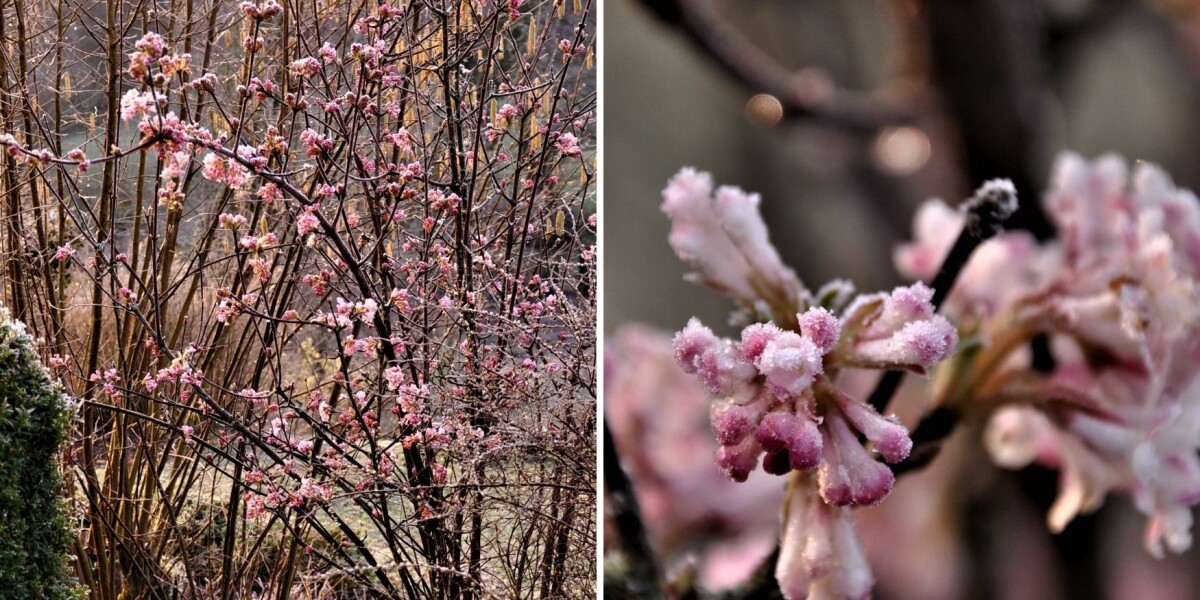
- Select a language for the TTS:
- UK English Female
- UK English Male
- US English Female
- US English Male
- Australian Female
- Australian Male
- Language selected: (auto detect) - EN
Play all audios:
I would love to take a walk at the Welsh garden of Bodnant this January – just for the scent of some of its most famous offspring, the three cultivars that form the hybrid group _Viburnum x
bodnantense_: ‘Dawn’, ‘Deben’ and ‘Charles Lamont’. For winter scent and long-lasting floral display (although it does get knocked back a little in frost), they are tops. Ask your local
population of Peacock butterflies: in fine weather they will be found feeding on a Bodnantense from early February. READ MORE: MEDITERRANEAN GARDEN IN SOUTH OF FRANCE IS A WINTER PARADISE
HAPPY IN MOST SOILS This group of plants is unassuming – twiggy and uninteresting during the summer months, so best kept to a wildish shrub border – but they step forward into the limelight
during December, January and February, teaming perfectly with red-stemmed dogwoods, willows and a carpet of purple hellebores. An added bonus: they settle happily on most soils and in most
positions, although full sun to dappled shade are preferred. They only slowly reach their three-metre height and spread after 10 to 20 years and their rather unprepossessing profiles are
easily disguised if they are forced to rub shoulders with hazel, forsythia and other late winter to spring-flowering shrubs in an informal setting. Make more to maximise the joy in such
positions: they are easily propagated from softwood cuttings, 10 to 25cm long, taken in mid-spring after flowering. READ MORE: GARDENING IN FRANCE: DIANTHUS OR PINKS ARE A CLASSIC PASSALONG
CUTTING WEIRD PERSONAL LINK TO FAMOUS GARDENER Although the hybridisation programme between _V. farreri_ and _V. grandiflorum_ that gave rise to these winter beauties was originally the
brainchild of a gardener called Charles Lamont at the Edinburgh Botanic Garden, it was Charles Puddle (second in a line of three famous Bodnant head gardeners), who actually birthed _V. x
bodnantense_. Don’t laugh, this line of Puddles were weighty, important characters in the twentieth century horticultural world – they now have their own memorial garden at Bodnant. I have a
weird personal link to this famous Puddle, since one of my mentors when I was a botanic garden trainee was a devilish old gardener called Fred who had been apprenticed to Charles back in
the late 1940s. ‘VIBURNUM REMINDS ME OF NAUGHTY FRED’ Fred would pass many happy hours with me, pricking out and reminiscing about Bodnant in its Lord Aberconway heyday, when the large
gardening team would think nothing of transplanting a massive azalea just a few metres. Less inspirational to a young gardener such as myself – but much funnier – he also had a host of
stories about how he and the other apprentices would defy the Puddle authority, sneaking naps in the glasshouses and evading work at all cost. As I enjoy ‘Charles Lamont’ (which has the
brightest pink flowers of the triumvirate) this January, I’m reminded not just of Bodnant and its famous Puddles, but also of naughty Fred. (I try to forget his ‘personal’ chemical cupboard,
kept locked, but whose contents nevertheless managed to escape in small threatening puffs. Less said about the toxic cocktail of chemicals to which those heroic early twentieth gardeners
were addicted, the better.) ‘PEOPLE IN WHITE COATS HAVE DONE IT AGAIN’ They’ve gone and done it again. Those ‘lumpers’ and ‘splitters’ – the people in white coats who like to ‘lump’ loads of
different plant genera together, or the others who like to ‘split’ them into increasingly smaller groups, using hairline differences. They’ve been at it since I was a horticultural student,
but with the advance of genetics in the study of botany their meddling has gathered pace. I guess I’m a bit behind the times, having only just noticed that as long ago as 2019 rosemary
slipped quietly from its own genus into Salvia and is now _Salvia rosmarinus_. CLARITY ON PLANT’S DNA Was it because of Covid that I missed out on this earth-shattering news? But, finally,
in autumn 2022, I caught up. Read the Head of Horticultural Taxonomy at the Royal Horticultural Society’s apologetic words on the subject: “We understand everyone involved in gardening finds
name changes difficult, especially when they relate to popular and widely grown garden plants such as rosemary. However, we cannot ignore what science is telling us and clarity on a plant’s
DNA helps us to better understand its growth habits and cultural needs.” LATIN IS INDISPENSABLE IN HORTICULTURE I know that many of you out there are profound refusers of Latin names. But
as someone who has worked more than once in foreign botanic gardens, I can assure you that Latin is indispensable if we want to have meaningful conversations with horticultural friends from
other countries. In fact, the common name ‘rosemary’ doesn’t really pose too many problems: it could pass in Spanish (_romero_), French (_romarin_) or Italian (_rosmarino_). But try using
s_ouci_ – the French word for marigold – in Germany where it is known as _Ringelblumen__._ I guess, because I am someone completely committed to ‘talking plants’ in Latin, I just have to
‘suck it up’ (as the Americans love to say). And I can be reassured by the information that if _Rosmarinus_ had continued to be recognised as a genus, this would have necessitated changing
the name of over 700 Salvia species; whereas, if rosemary slips quietly into ‘salvia-dom’, we are looking at only 15 little earth tremors. RELATED ARTICLES RECYCLING, REPAIRS, RECEIPTS:
ENVIRONMENTAL CHANGES IN FRANCE IN 2023 HOW TO KEEP YOUR CHRISTMAS CYCLAMEN ALIVE ALL YEAR IN FRANCE HOW TO BUILD A SNAKE HOTEL IN YOUR FRENCH GARDEN AS POPULATION FALLS

:max_bytes(150000):strip_icc():focal(319x0:321x2)/people_social_image-60e0c8af9eb14624a5b55f2c29dbe25b.png)



